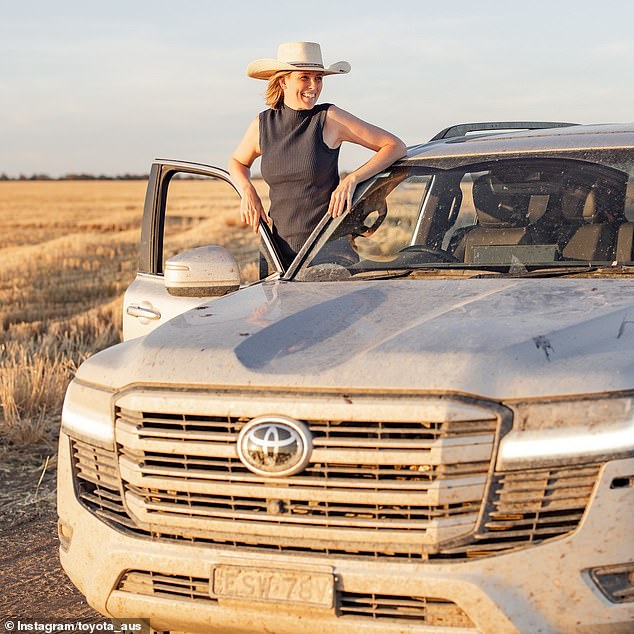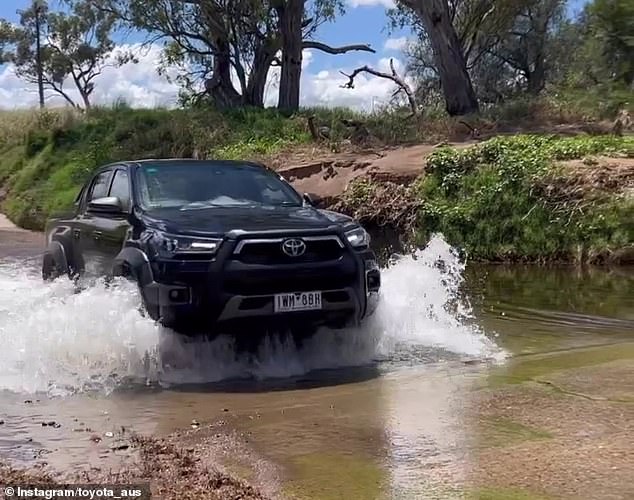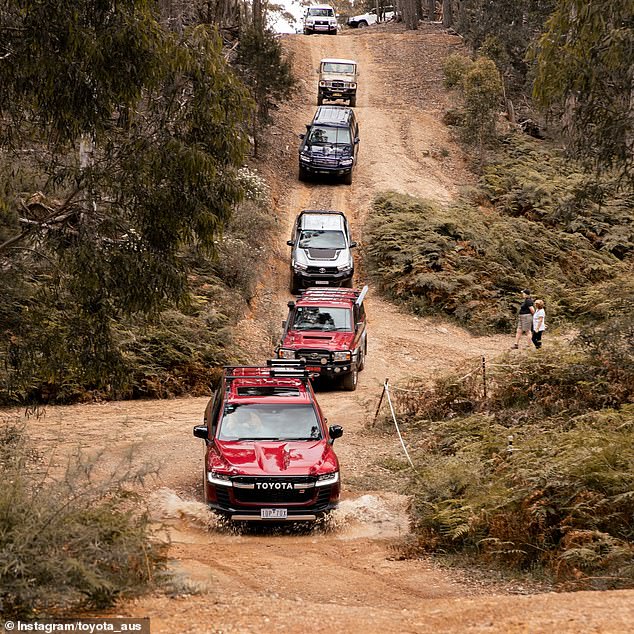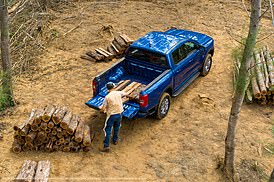Revealed: The big impact Chris Bowen’s new fuel emissions standards could have on SUVs and ute owners
Anthony Albanese’s government is being warned that new fuel efficiency standards coming into force next year could threaten the payload and towing capabilities of heavy-duty four-wheel drive vehicles and utes.
Industry groups have generally welcomed the concept of an Australian fuel efficiency standard to reduce CO2 emissions.
But there are concerns that motorists will have less choice when it comes to rugged off-road vehicles if the same standard is applied to smaller passenger cars and large SUVs such as the Toyota LandCruiser.
Minister for Climate Change and Energy Chris Bowen and Transport Minister Catherine King argued on Sunday that the Government’s New Vehicle Efficiency Standard would effectively give motorists more choice of new cars, utes and vans ‘that use less fuel and which have so far only been available goods’ to buyers in overseas markets’.
Labor is being warned that new fuel efficiency standards coming into force next year could threaten the carrying capacity of heavy-duty four-wheel drives and utes (pictured is a Ford Ranger towing a caravan)
They claimed Australian motorists would save $1,000 a year by 2028 with the new policy.
Labor Cabinet ministers welcomed the American Corporate Average Fuel Economy (CAFE) Standards, which from 2026 will require every automaker’s new fleet to travel 49 miles per gallon – or an average of just 4.8 liters per 100 kilometers.
US President Joe Biden has ordered carmakers to make half their sales from electric vehicles by 2030, to combat the high fuel consumption of giant American pickups such as the Ford F-150, Chevrolet Silverado and RAM – the three most popular models – to compensate. last year.
Australia’s three most popular models in 2023 were also utes, albeit much smaller.
But to achieve lower average fuel consumption, car manufacturers would also have to sell many more electric and hybrid cars.
Carmakers could also choose to sell only hybrid or electric versions of their SUVs and utes, or phase out petrol or diesel versions entirely to meet strict fuel efficiency and emissions standards.
They would have a weaker pulling power.
The Ford Ranger, Australia’s best-selling car in 2023, uses 8.4 liters per 100km, based on the consumption of a popular V6 diesel double-cab engine. This ute has a load capacity of 985 kilograms, but the workhorses of the series can carry up to 1.3 tons.
The Toyota HiLux, Australia’s second most popular vehicle in 2023, used the same amount of fuel, based on figures for a 4×4 diesel.
The Toyota LandCruiser, the fifth most popular vehicle in Australia last year, can tow 3.5 tonnes and consumes 8.9 liters per 100km.
Last year, electric cars accounted for 7.2 percent of new car sales, with the popular Tesla Model Y classified as an SUV.
That figure rose to 16.2 percent when electric vehicles were grouped with hybrids and plug-in hybrids.
The Federal Chamber of Automotive Industries argued that applying the same standards too broadly would compromise the off-road capabilities of all-wheel drive.
“There are clear arguments for adopting separate emissions targets for different categories of vehicles,” the report said in a submission last May.

Industry groups have generally welcomed the concept of an Australian fuel efficiency standard, but there are concerns that motorists would have less choice when it comes to rugged off-road vehicles if the same standard were applied to smaller passenger cars and large SUVs such as the Toyota LandCruiser. pictured)

Minister for Climate Change and Energy Chris Bowen (pictured) and Transport Minister Catherine King argued on Sunday that the Government’s New Vehicle Efficiency Standard would effectively give motorists more choice of new cars, trucks and vans ‘that use less fuel and which have so far was previously only available to buyers in overseas markets’.
‘The main use case of commercial vehicles and of large all-wheel drive off-road SUVs is the ability to carry a load and traverse difficult and often challenging terrain.’
The Federal Chamber of Automotive Industries argued that blanket fuel efficiency standards would mean using electric vehicles with heavy batteries, which in turn would have inferior carrying capacity.
“The above-mentioned use case of light commercial vehicles and their payload requirements make it more challenging to electrify their powertrain,” the report said.
“The mass of traction batteries and other EV hardware detracts from the payload available for commercial purposes.”
Last year, SUVs accounted for 55.8 percent of new vehicle sales, with this broad category including cars with higher ground clearance, ranging from small two-wheel drive hatchbacks like the Mazda CX-3 to larger four-wheel drive like the Toyota LandCruiser.
The light commercial category, which includes utes, had a 22.5 percent market share but made up Australia’s three best sellers, the Toyota HiLux, Ford Ranger and Isuzu D-Max.
Fuel efficiency standards are also designed to tackle climate change as part of Labour’s plan to cut carbon emissions by 43 per cent by 2030.
Labor plans to introduce this an Australian New Vehicle Efficiency Standard from January 1, 2025, with a plan to catch up with US regulations by 2028.
The Department of Infrastructure, Transport and Regional Development argued in a frequently asked questions section that Australian motorists could continue to buy four-wheel drive and cars “that can tow my trailer and boat”.
‘Yes. A New Vehicle Efficiency Standard allows suppliers to choose how they meet the emissions reduction target,” the report said.
‘In other countries with a new vehicle efficiency standard, 4WDs and utes are still widely available.
‘Although the EU market has a strict standard, vehicle models such as the Toyota HiLux and Landcruiser and Ford Rangers are still sold.’
Labor also plans to introduce European ‘harmful emissions standards’ from December 2025 carbon monoxide, hydrocarbons and nitrogen oxides, based on Euro 6d rules.
Cars that met the Euro 6d rule produced less than 162 grams of carbon dioxide per kilometer on average, according to tests by British consumer group Which? showed.

The Federal Chamber of Automotive Industries argued that blanket fuel efficiency standards would mean using electric vehicles with heavy batteries, which in turn would have inferior carrying capacity (pictured is a diesel Toyota HiLux)

Fuel efficiency standards are also designed to tackle climate change as part of Labour’s plan to cut CO2 emissions by 43 per cent by 2030 (pictured are Toyota all-wheel drive vehicles)
But the EU plans to tighten its Euro 6d rules so that new passenger cars sold by 2025 emit less than 95 grams of carbon per kilometer, with a rule of 147 grams for light commercial vehicles.
A report from the National Transport Commission cited data from the Federal Chamber of Automotive Industries showing that new passenger cars sold in 2021 emitted 146.5 grams of CO2 per kilometer, compared to 212.5 g/km for heavy-duty SUVs and light commercial vehicles.
FCAI chief executive Tony Weber said plans for a 60 per cent reduction in vehicle emissions are “very ambitious”.
“It will be a challenge to see if they are feasible, taking into account the total cost of ownership,” he said on Sunday.
“Most importantly, Australian families and businesses can continue to have access to the vehicle type that suits their work and leisure needs.”

